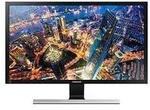Was looking for 4K monitor for gaming (mainly Counter Strike) + development work and found this.
Highlights
Samsung LU28E590DS/XY 28 UHD 3840×2160
- 1MS Response Time
- Display Port+ 2xHDMI 1.4 (v2.0) for 60Hz
- VESA
- Free Sync
- 3 years perfect panel warranty
- Dimensions: 74cm x 46cm x 13cm
- Weight: 7.6kg
Same Monitor is available in Bing Lee for 699$
And it has got decent reviews at Amazon





The one @ BL is 38" according to specs…